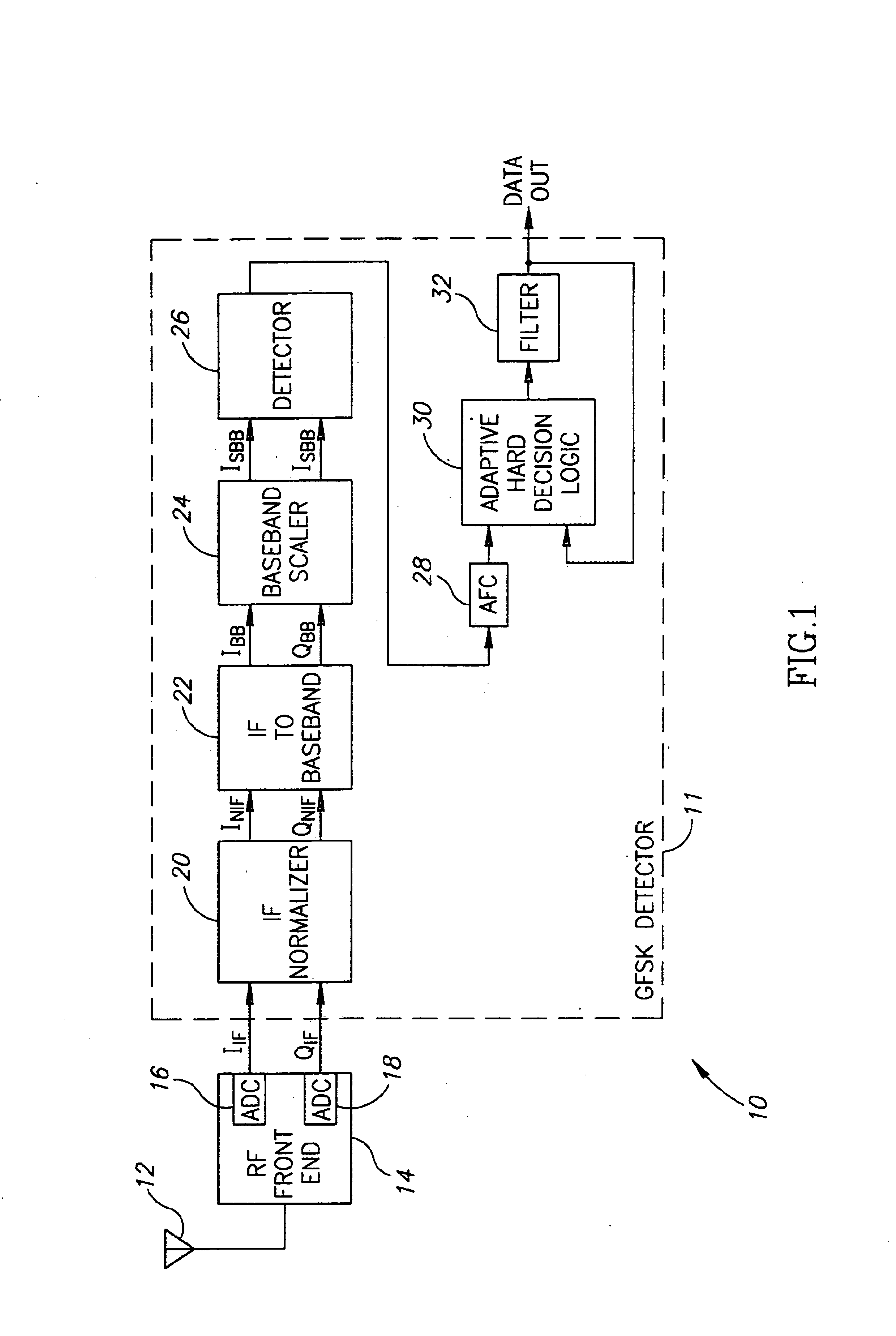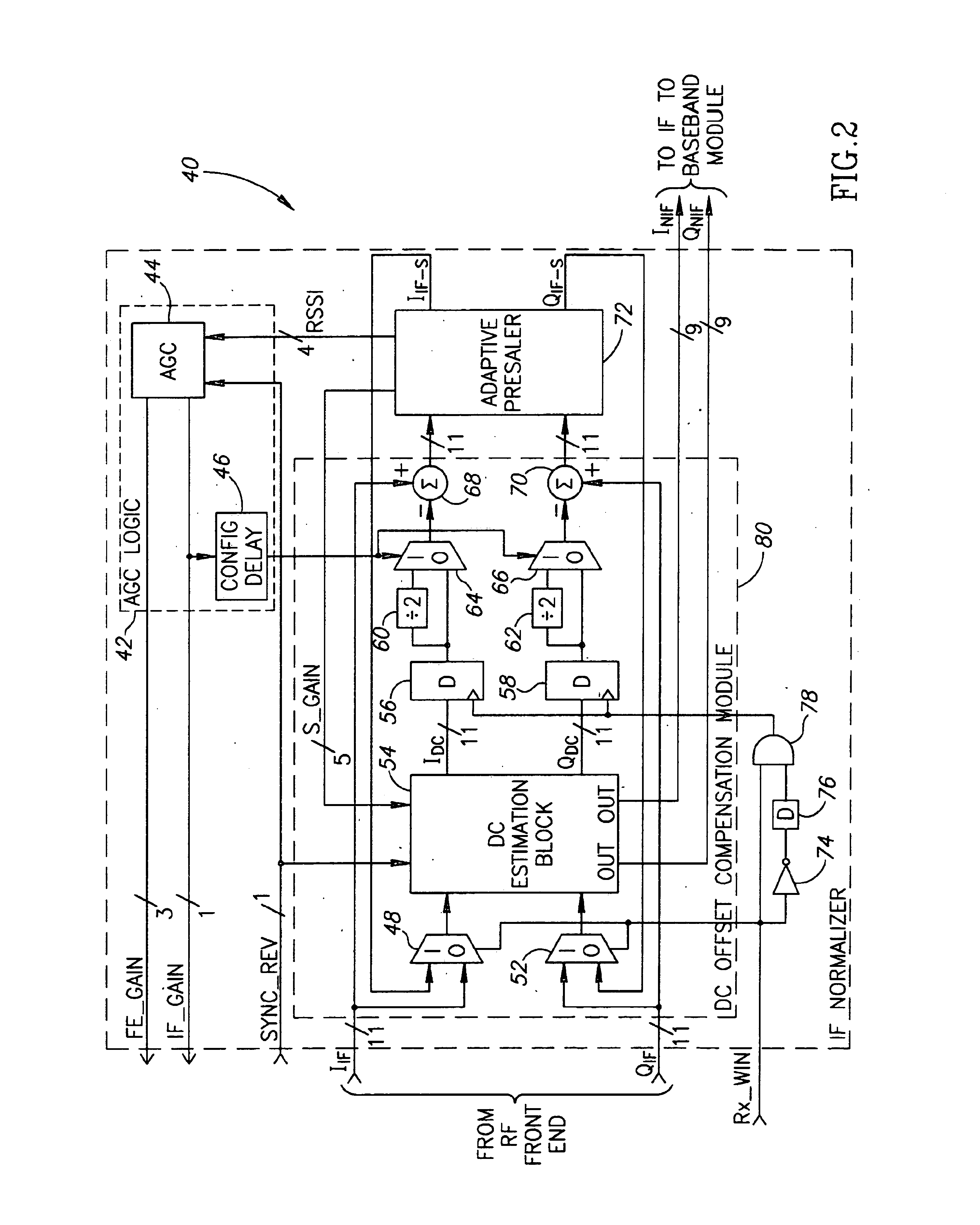[0012]An
advantage of the present invention is that the DC compensation mechanism can be implemented in a relatively small size (i.e. low
gate count) and adapts quickly to changing DC levels. This is in comparison to prior art solutions based on linear filtering that require relatively high gate counts to achieve sufficient filtering and have extended
adaptation times. Another
advantage is that in applications where the input signal is at low IF (i.e. near zero IF), the nonlinear nature of the mechanism of the present invention permits
adaptation to any DC level without distorting the signal itself even in the case of near zero IF. This is in contrast to prior art solutions where filtering distorts the signal's spectrum and causes performance degradation. For example, suppressing DC which is 100 dB above the level of the received signal and is very close to it in frequency (IF of 500 kHz) is almost impossible using linear filtering.
[0013]Another advantage is that the DC compensation mechanism of the present invention provides fine DC
offset cancellation using the multi-stage architecture wherein the final stage operates on a scaled signal. A further advantage is the very low
gate count to implement the mechanism
stemming from the reuse of the DC estimation hardware.
[0014]Note that many aspects of the invention described herein may be constructed as
software objects that are executed in embedded devices as
firmware,
software objects that are executed as part of a
software application on either an embedded or non-embedded computer
system running a real-time
operating system such as WinCE, Symbian, OSE, Embedded LINUX, etc. or non-
real time operating system such as Windows,
UNIX, LINUX, etc., or as
soft core realized HDL circuits embodied in an
Application Specific Integrated Circuit (ASIC) or
Field Programmable Gate Array (FPGA), or as functionally equivalent discrete hardware components.
[0015]There is thus provided in accordance with the present invention a method of DC offset estimation, the method comprising the steps of determining a current maximum
peak value of an input signal, determining a current minimum
peak value of the input signal and calculating an average of the current maximum
peak value and the current minimum peak value to yield a DC offset estimate.
[0016]There is also provided in accordance with the present invention an apparatus for DC offset compensation comprising first means for determining a current maximum peak value of an input signal comprising, means for comparing the input signal with a previous maximum peak value, means for adding the current maximum peak value to a first difference between the input signal and the previous maximum peak value, the first difference multiplied by a maximum charge coefficient to yield the current maximum peak value if the input signal is greater than the previous maximum peak value, means for subtracting a second difference between the current maximum peak value and the input signal multiplied by a maximum
discharge coefficient from the previous maximum peak value to yield the current maximum peak value if the input signal is not greater than the previous maximum peak value, second means for determining a current minimum peak value of the input signal comprising, means for comparing the input signal with a previous minimum peak value, means for subtracting a first difference between the current minimum peak value and the input signal, the first difference multiplied by a minimum
discharge coefficient and subtracted from the previous minimum peak value to yield the current minimum peak value if the input signal is greater than the previous maximum peak value, means for adding the current minimum peak value to a second difference between the input signal and the previous minimum peak value, the second difference multiplied by a minimum charge coefficient to yield the current minimum peak value if the input signal is not greater than the previous minimum peak value, third means for calculating an average of the current maximum peak value and the current minimum peak value to yield a DC offset estimate and fourth means for subtracting the DC offset estimate from the input signal to yield a DC offset compensated output signal.
[0017]There is further provided in accordance with the present invention an method of amplitude adjustment and DC offset compensation, the method comprising the steps of first performing coarse DC offset compensation comprising the steps of determining a first current maximum peak value of an input signal, determining a first current minimum peak value of the input signal, calculating an average of the first current maximum peak value and the first current minimum peak value to yield a first DC offset estimate, subtracting the first DC offset estimate from the input signal to yield a first DC offset compensated signal, scaling the first DC offset compensated signal to within a predefined range of amplitudes to yield a scaled signal, second performing fine DC offset compensation comprising the steps of determining a second current maximum peak value of the scaled signal, determining a second current minimum peak value of the scaled signal, calculating an average of the second current maximum peak value and the second current minimum peak value to yield a second DC offset estimate and subtracting the second DC offset estimate from the scaled signal to yield an output DC offset compensated signal.
 Login to View More
Login to View More  Login to View More
Login to View More 


